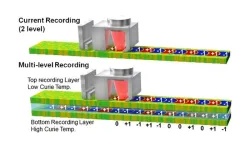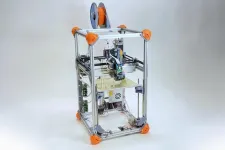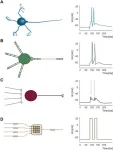(Press-News.org) ABSTRACT CT014
SAN DIEGO – The first-in-class PARP1-selective inhibitor saruparib demonstrated encouraging early efficacy and a favorable safety profile in patients with homologous recombination repair (HRR)-deficient breast cancers, according to results from the Phase I/II PETRA trial led by researchers at The University of Texas MD Anderson Cancer Center.
Results from the first-in-human trial were presented today at the American Association for Cancer Research (AACR) Annual Meeting 2024 by Timothy Yap, M.B.B.S., Ph.D., professor of Investigational Cancer Therapeutics and vice president and head of clinical development in the Therapeutics Discovery division.
A total of 31 patients with advanced breast cancers harboring HRR deficiency mutations received the optimal recommended dose of 60 mg of saruparib. The objective response rate was 48.8% with a median progression-free survival of 9.1 months. The drug had favorable tolerability as well as pharmacokinetic and pharmacodynamic responses.
“Saruparib is a first-in-class, highly selective and potent new generation PARP1-selective inhibitor with a wide therapeutic index,” Yap said. “The favorable safety profile of saruparib together with the low dose-reduction rate compared to approved PARP inhibitors may allow patients to remain on treatment longer at an optimal dose, offering maximal pharmacokinetic exposure and pharmacodynamic engagement, which could lead to improved efficacy.”
Poly-ADP ribose polymerase (PARP) inhibition previously was shown to be particularly effective in cancers harboring gene mutations that negatively affect DNA repair, such as BRCA1/2 mutations, because these cancers rely even more than others on PARP proteins to repair any DNA damage. By inhibiting PARP proteins, these cancers are unable to repair their DNA, leading to an inability to replicate and, ultimately, cell death.
Saruparib is a new-generation oral inhibitor selectively targeting PARP1, whereas previous PARP inhibitors targeted both PARP1 and PARP2. While these first-generation inhibitors have become the standard of care for certain cancers, the improved safety profile of saruparib could allow for more combinations with other treatments and opportunities to bring the benefits of PARP inhibitors to patients in earlier disease stages.
The trial included 141 patients who were eligible for safety analysis at a 60 mg dose. Of these, only 14.2% had to reduce dosage and just 3.5% had to discontinue treatment due to treatment-related adverse events. The most common adverse events were anemia, neutropenia, thrombocytopenia, fatigue and asthenia.
According to Yap, the safety profile of this heavily pretreated patient population compared favorably to Phase III data from approved first-generation PARP inhibitors. In follow-up to these findings, rational saruparib combination strategies currently are being tested, including clinical evaluation in the Phase III trial setting, Yap noted.
This study was funded by AstraZeneca. A full list of collaborating authors and their disclosures can be found with the abstract here.
Read this press release in the MD Anderson Newsroom. Information on all MD Anderson AACR Annual Meeting content can be found at MDAnderson.org/AACR.
END
AACR: PARP1-selective inhibitor demonstrates early efficacy in breast cancers with DNA repair defects
Saruparib showed favorable safety profile over first-generation PARP inhibitors in Phase I/II trial
2024-04-08
ELSE PRESS RELEASES FROM THIS DATE:
City of Hope scientists present leading-edge research at American Association for Cancer Research (AACR) Annual Meeting
2024-04-08
LOS ANGELES — Researchers with City of Hope®, one of the largest cancer research and treatment organizations in the United States, will present more than 70 abstracts and sessions on innovative clinical trial results, breakthrough diagnostic techniques and advances in treatment options as well as share their expertise on molecular profiling and the microbiome at the AACR Annual Meeting, which started April 5 and ends April 10 in San Diego.
In addition to City of Hope’s robust data being presented throughout the meeting, John D. Carpten, Ph.D., the Irell & Manella Cancer Center Director’s ...
Adagrasib plus cetuximab may provide clinical benefit in patients with KRASG12c-mutated colorectal cancer
2024-04-08
SAN DIEGO – A combination of the KRASG12C inhibitor adagrasib (Krazati) and the anti-epidermal growth factor receptor (EGFR) antibody cetuximab (Erbitux) showed clinical activity and promising survival outcomes in a cohort of patients with metastatic, heavily pretreated, KRASG12C-mutated colorectal cancer, according to results from the phase I/II KRYSTAL-1 trial presented at the American Association for Cancer Research (AACR) Annual Meeting 2024, held April 5-10.
The study was simultaneously published in Cancer Discovery.
KRASG12C mutations occur in around 4% of colorectal cancers and are associated with a poor prognosis. Drugs targeting KRASG12C, such as adagrasib, have emerged ...
Next-generation PARP inhibitor demonstrates clinical benefit in patients with homologous recombination repair-deficient breast cancer
2024-04-08
SAN DIEGO – Saruparib, a selective inhibitor of poly-ADP ribose polymerase 1 (PARP1), demonstrated a promising objective response rate and progression-free survival in patients with certain homologous recombination repair (HRR)-deficient breast cancers, according to results from the phase I/II PETRA trial presented at the American Association for Cancer Research (AACR) Annual Meeting 2024, held April 5-10.
Although blocking the enzyme PARP1 may be sufficient to prevent DNA repair in HRR-deficient tumors, all PARP inhibitors currently approved by the ...
An exosome-based liquid biopsy shows promise for early detection of pancreatic cancer
2024-04-08
SAN DIEGO – An investigational exosome-based liquid biopsy accurately detected 97% of stage 1-2 pancreatic cancers when combined with the biomarker CA 19-9, according to research presented at the American Association for Cancer Research (AACR) Annual Meeting 2024, held April 5-10.
“Pancreatic cancer is one of the most fatal malignancies, in large part because the majority of patients are diagnosed only after the cancer has already metastasized,” said Ajay Goel, PhD, senior author of the study and the chair of the Department of Molecular ...
Proof-of-principle demonstration of 3-D magnetic recording
2024-04-08
1. Research groups from NIMS, Seagate Technology, and Tohoku University have made a breakthrough in the field of hard disk drives (HDD) by demonstrating the feasibility of multi-level recording using a three-dimensional magnetic recording medium to store digital information. The research groups have shown that this technology can be used to increase the storage capacity of HDDs, which could lead to more efficient and cost-effective data storage solutions in the future.
2. Data centers are increasingly storing vast amounts of data on hard disk drives (HDDs) that use perpendicular ...
This 3D printer can figure out how to print with an unknown material
2024-04-08
While 3D printing has exploded in popularity, many of the plastic materials these printers use to create objects cannot be easily recycled. While new sustainable materials are emerging for use in 3D printing, they remain difficult to adopt because 3D printer settings need to be adjusted for each material, a process generally done by hand.
To print a new material from scratch, one must typically set up to 100 parameters in software that controls how the printer will extrude the material as it fabricates an object. Commonly ...
Brain-inspired computing may boil down to information transfer
2024-04-08
The biological brain, especially the human brain, is a desirable computing system that consumes little energy and runs at high efficiency. To build a computing system just as good, many neuromorphic scientists focus on designing hardware components intended to mimic the elusive learning mechanism of the brain. Recently, a research team has approached the goal from a different angle, focusing on measuring information transfer instead. Their method went through biological and simulation experiments and then proved effective in an electronic neuromorphic system. It was published ...
Youths with mood disorders 30 percent less likely to acquire driver’s license than peers
2024-04-08
Philadelphia, April 8, 2024 – Researchers from Children’s Hospital of Philadelphia (CHOP) found that teens and young adults with mood disorders, such as depression and bipolar disorder, were 30% less likely to obtain their driver’s license than peers without such disorders. Additionally, those youths with mood disorders experienced a slightly elevated risk of crashing. These findings suggest that these teens and young adults could benefit from guidance on obtaining licensure and accessing training to avoid crashes when they are newly licensed.
The findings were published online today ...
Opening a new front against pancreatic cancer
2024-04-08
NEW YORK, NY (April 8, 2024)--A new type of investigational therapeutic in development for pancreatic cancer has shown unprecedented tumor-fighting abilities in preclinical models of the disease, suggesting it has the potential to offer novel treatment options for nearly all pancreatic tumors, a comprehensive study has found.
The inhibitors in this new class of oral medications, being developed by Revolution Medicines Inc., target the oncogenic or active cancer-causing form of RAS proteins (such as KRAS, NRAS, and HRAS). These RAS “oncoproteins” drive up to a third of all human cancers. The research ...
More premature babies born following Swedish parental leave policy
2024-04-08
The introduction of a policy protecting parental leave benefits in Sweden in 1980 had unintended consequences on child health. The policy led to an increase in premature birth rates. This is shown by a study from researchers at Stockholm University, published in JAMA Pediatrics.
The Swedish so-called speed premium policy was introduced in 1980 in order to protect couples’ level of income-based parental leave benefits when they had children in quick succession. The new study from Stockholm University evaluates the health consequences of the policy. The researchers conclude that by ...
LAST 30 PRESS RELEASES:
Tai chi as good as talking therapy for managing chronic insomnia
Monthly injection helps severe asthma patients safely stop or reduce daily steroids
The Lancet Respiratory Medicine: Monthly injection may help severe asthma patients safely reduce or stop daily oral steroid use
Largest study reveals best treatment options for ADHD
Tsunami from massive Kamchatka earthquake captured by satellite
Hidden dangers in 'acid rain' soils
Drug developed for inherited bleeding disorder shows promising trial results
New scan could help millions with hard-to-treat high blood pressure
9th IOF Asia-Pacific Bone Health Conference set to open in Tokyo
Can your driving patterns predict cognitive decline?
New electrochemical strategy boosts uranium recovery from complex wastewater
Study links America’s favorite cooking oil to obesity
Famous Easter Island statues were created without centralized management
Captive male Asian elephants can live together peacefully and with little stress, if introduced slowly and carefully, per Laos case study of 8 unrelated males
The Galapagos and other oceanic islands and Marine Protected Areas (MPAs) may be "critical" refuges for sharks in the Tropical Eastern Pacific, as predatory fish appear depleted in more coastal MPAs t
Why are shiny colours rare yet widespread in nature?
Climate-vulnerable districts of India face significantly higher risks of adverse health outcomes, including 25% higher rates of underweight children
New study reveals spatial patterns of crime rates and media coverage across Chicago
Expanding seasonal immunization access could minimize off-season RSV epidemics
First-of-its-kind 3D model lets you explore Easter Island statues up close
foldable and rollable interlaced origami structure: Folds and rolls up for storage and deploys with high strength
Possible therapeutic approach to treat diabetic nerve damage discovered
UBC ‘body-swap’ robot helps reveal how the brain keeps us upright
Extensive survey of Eastern tropical Pacific finds remote protected areas harbor some of the highest concentrations of sharks
High risk of metastatic recurrence among young cancer patients
Global Virus Network statement on the Marburg virus outbreak in Ethiopia
'Exploitative' online money gaming in India causing financial, health and social harm, analysis shows
Mayo Clinic researchers identify why some lung tumors respond well to immunotherapy
The pterosaur rapidly evolved flight abilities, in contrast to modern bird ancestors, new study suggests
Farms could be our secret climate weapon, QUT-led study finds
[Press-News.org] AACR: PARP1-selective inhibitor demonstrates early efficacy in breast cancers with DNA repair defectsSaruparib showed favorable safety profile over first-generation PARP inhibitors in Phase I/II trial



